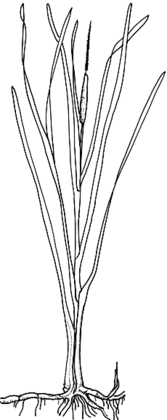
Description: Erect emergent rhizomatous aquatic perennials; rhizomes extensive, branched, the branches ending in stiff, erect, leaf-bearing stems terminated by spike-like inflorescences; stems terete, rigid, pithy.
Leaves with sheaths overlapping, in 2 rows, closely encircling the stem, and auricles variously developed; blade more or less erect, linear, often spongy within, obtuse to acute.
Inflorescence densely compact, velvety brown, spike-like, with male and female flowers usually separated by a length of stem. Flowers unisexual, protandrous, males above, females below. Perianth absent or sometimes interpreted as being replaced by a variable number of long bracts or long hairs. Male flowers with 1–7 stamens. Female flowers borne on very short lateral branches; usually both sterile and fertile female flowers present, subtended by several hairs on an elongated axis; fertile female flower with a 1-ovuled ovary with a filiform style terminally expanded into a stigma; sterile female flower either imperfectly developed or modified into a club-shaped carpodium.
Individual fruit a 1-seeded follicle.
Distribution and occurrence: World: c. 15 species, cosmopolitan. Australia: 3 species (2 species native, 1 species naturalized), all States.
Text by S. W. L. Jacobs
Taxon concept:
| | Key to the species | |
| 1 | Female inflorescence dark brown or red-brown; stigma narrow-obovate to obovate, somewhat fleshy | Typha latifolia |
| Female inflorescence cinnamon- or chestnut-brown; stigma linear to narrow-obovate, not fleshy | 2 |
| 2 | Upper leaves usually without a distinct auricle (the top 1 or 2 may be auriculate); stigmas linear; bracts in female inflorescence numerous, spathulate (4–8 cells across); mature female spikes usually less than 20 mm diam.; male and female spikes separated by 0.5–5 cm | Typha domingensis |
| Upper leaves usually with a distinct auricle; stigmas narrow-obovate; bracts in female inflorescence few, narrow-spathulate (3 or 4 cells across); mature female spikes 10–40 mm diam.; male and female spikes separated by 0–5 cm
Back to 1 | Typha orientalis |
|


